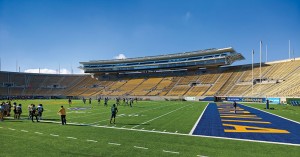Protecting and Strengthening a Landmark on an Active Fault
Forell/Elsesser Engineers, Inc. was an Outstanding Award Winner for the UC Berkeley California Memorial Stadium Seismic Upgrade project in the 2013 NCSEA Annual Excellence in Structural Engineering awards program (Category – Forensic/Renovation/Retrofit/Rehabilitation Structures).
Built as a memorial to fallen heroes of World War I from California, Memorial Stadium has endured as one of the most picturesque venues in college football from its opening in 1923 for the “Big Game” versus Stanford to the present day. Over the years, the original Stadium had shown its age and also shown signs of how the earth is slowly creeping on the Hayward Fault beneath it. This movement had shown up through leaning columns, building cracks, and column offsets and misalignments. The challenge for the design team was how to preserve this monument in place and ensure the safety of its occupants should a large earthquake occur.
Due to the site location and geology, design for large ground motions dominated the engineering decisions that were made about the structure. The unique thing about Memorial Stadium is that it not only needed to be designed for the strong ground motions, but also needed to accommodate potential surface rupture of the Hayward Fault below certain portions of the building. Geologists on the project located and mapped the Hayward Fault around the Stadium. Due to the historic nature of the Stadium and its location adjacent to campus, it was decided to retrofit the structure in place and develop a solution that safely accommodated the potential surface rupture.
Through an interdisciplinary effort between structural engineers, geologists, seismologists, and geotechnical engineers, a scheme was designed to accommodate the estimated 6 feet of lateral movement and simultaneous 2 feet of vertical movement that could occur on site. For Memorial Stadium, this meant breaking the seating bowl into discrete blocks where the fault crossed so that these portions of the building could move in response to possible surface rupture without affecting the rest of the structure. The challenge was to determine the best location and the optimum width for these joints while still accommodating the architectural design of the building. Through study of this problem with advanced finite-element modeling and through physical study models, along with many meetings and debates between the engineers, geologists, and seismologists, a final scheme was developed that satisfied the requirements of all the stakeholders.
While a large portion of the engineering effort was devoted to solving the issue of accommodating surface rupture, another large engineering challenge also dominated the design of the stadium. One of the signature architectural features of the Stadium is a two story, 375-foot long press box that hovers above the west side of the seating bowl. This press box not only houses print, radio, and TV media, but also has a club space with views and seating facing the field and a dramatic 25-foot cantilever balcony that faces campus with views of the San Francisco Bay and the Golden Gate beyond.
While designing a press box on limited supports to give the appearance of “hovering” is a challenge, the real challenge came in safely bracing this structure for large potential ground motions at this site. The press box structure is designed as a 3D space truss with diagonals in all directions which allows the structure to cantilever toward the field, span 90 feet between vertical supports, and be braced seismically between the supporting cores. Even with the extensive bracing, the press box is still relatively flexible when compared with the concrete stadium seating bowl below. As the design progressed, the engineers realized that a large flexible steel structure on four slender concrete core walls attaching to a very stiff triangular seating bowl created a dynamic incompatibility within the combined structure. In addition to conflicting dynamics, there would also be a high concentration of damage to the core walls where they attached to the seating bowl, this was a big concern since the cores serve as the only path for exit stairs and elevators, as well as providing gravity support for the press box itself.
Through many iterations of design, a solution that simultaneously solved the biggest concerns was developed: provide a separation between the bowl and press box structures and allow them to move independently, and link them with fluid viscous dampers. These dampers buffer the movements between the two structures, tempering the accelerations in the press box. To protect the tall slender core walls supporting the press box, the engineers intended them to rock as a rigid body at their base instead of trying to fix them to the foundation system rigidly. Vertical post-tensioning was utilized in all the cores and allows them to rock by providing a restoring force and a constant compression force to help them remain elastic. The combination of the vertical post-tensioning and fluid viscous dampers allows the two structures to work together to resist strong ground motions.
With this project complete, Memorial Stadium is safe for the effects of surface rupture and ground shaking from the Hayward fault while retaining it’s iconic historic façade and providing UC Berkeley with all the amenities of a modern facility. Memorial Stadium is now the envy of the PAC12 and provides Cal fans with a safe place to spend a fall afternoon cheering on their team.▪

